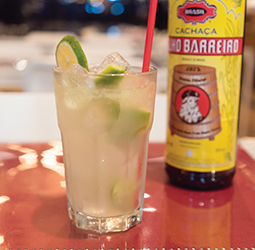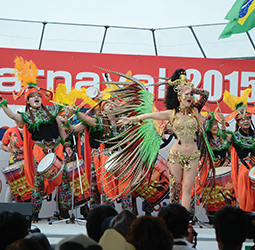Home > Highlighting JAPAN >Highlighting Japan January 2016>Delectable Journeys
Highlighting JAPAN


- PREVIOUS
- NEXT
The World Comes Together in Japan
Although many view Japan as a homogenous society, in reality it is home to many people from abroad who have come for love, for business, for family, or to flee war or strife. They learn to love Japan, absorb the language and culture, and make connections with people. They also bring their unique cultures and traditions. These three different ethnic communities in Japan offer a feel for the flavors and cultures they share.
Oizumi-machi is a town in Gunma Prefecture of roughly forty thousand people. Home to many factories of major manufacturers, a large number of overseas workers came to the town starting in the late 1970s, resulting in an unusually high number of Japanese Nikkei (meaning “of Japanese descent”) Brazilians living in the area. In fact, says Oizumi Tourism staff member Masaki Nakayama, the town has Japan’s highest concentration of Brazilians—about 10 percent of the population, with an additional 5 percent of residents hailing from places like Peru and Bolivia.
Canta Galo (The Singing Rooster) is a little grocery store with a large variety of goods, selling sweets, mate tea, spices and more. The store is run by the Kuroki family, who have been in Japan for about twenty-five years. The proprietors switch effortlessly between Portuguese and Japanese while serving customers. They also help with translation and interpretation, and Canta Galo’s walls are covered with fliers in Portuguese advertising jobs and apartments to let.
Down the road is big, bustling Takara Supermarket, with a bakery and a full-service butcher doing cuts Brazilian style—thick steaks, ribs and sausages. The store’s café, Rodeio Grill, is run by the affable Marco Antonio Miyazaki, and serves many Brazilian favorites, including burgers made from Takara’s freshly ground meat and served on soft bakery rolls, churrasco (Brazilian barbecue) sausages perfectly grilled to a crisp, and a piquant house sauce made from peppers, onion, garlic and herbs.
Restaurante Brasil, Japan’s first Brazilian restaurant, specializes in national dishes such as churrasco and feijoada. Owner Daniel Iwata explains that his churrasco uses picanha, a cut of beef called the rump cap that is Brazil’s favorite. Also on the menu are chicken drumsticks, spareribs and Brazilian-style pork, grilled on skewers over charcoal and served with rice and pickles.
Those craving nightlife should head over to Kaminalua. The owner, former pro baseball player Norbert Semanaka da Rocha, serves a delicious array of snacks, cocktails and sweets. His caipirinha, a sublime sweet-tart concoction that is Brazil’s national cocktail, is made from cachaça (sugarcane liquor). The coffees here are strong and dark, served with sweetened, condensed milk and cinnamon, and for dessert there are pasteles, a fried pastry filled with things like guava paste and cream cheese, chocolate and banana, or doce de leite, a kind of milk caramel.
Takadanobaba, a delightful mouthful of a neighborhood in Tokyo, is a college community that also happens to be where a large concentration of people from Myanmar (Burma) can be found. The streets near the station feature a double handful of Burmese restaurants, shops and community groups dedicated to Burmese concerns.
Mingalaba (which means “hello” in Burmese) is the area’s oldest Burmese restaurant, opened in 1997. The place serves popular dishes like lahpet—a fermented tealeaf salad bursting with crunchy treats like sesame seeds, peanuts, garlic and cabbage—along with fish sauce, tomato and shrimp. Often eaten with rice, lahpet is Myanmar’s most popular dish, and goes down well when served with Myanmar tea, a lightly fermented tea similar to oolong.
In Tak 11, a nondescript office building a few blocks away, the eleven floors house several small shops selling Burmese groceries and men’s clothing and accessories. At Mother House, friendly, chatty women explain the uses of various ingredients and introduce the odd-looking vegetables in bins. Proprietor Lili says that 80 percent of their customers are Burmese.
Sayarma Ma Hay Mar founded the Japan Myanmar Culture Center (JMCC) in 2002 to facilitate cultural exchange between the two countries. Ma Hay Mar says people from Myanmar began establishing businesses in the area after Takadanobaba laid the groundwork for welcoming overseas workers some twenty years ago. She estimates that the area now has around fifteen hundred Burmese residents, with around ten thousand in total living in Japan. The JMCC offers language lessons in Burmese to Japanese people and in Japanese to Burmese immigrants in the area. Along with a host of volunteers from both countries, Ma Hay Mar handles consultation, interpretation and translation between Japanese and Burmese, helping newcomers with their transition.
Jagmohan Chadrani first came to Tokyo from India in 1979, settling in Tokyo’s Edogawa Ward in an area called Nishi-Kasai. He began importing Indian tea to Japan in 1981, and recalls that at the time there was no train station in the area. There were also very few Indian people back then, and Indian restaurants were very rare.
That changed around 1999 when, due in part to the Y2K scare, Indian IT engineers started arriving in droves. Since about half of them were strict vegetarians, eating out was a difficult proposition.
In 1999, Chadrani started a cafeteria open in the evenings where the mostly single engineers could eat, with the emphasis on simple home cooking. They found the place a balm for the loneliness that so often comes with moving to a new country. “Food makes your day, that’s the feeling we got when we started,” says Chadrani. “People began feeling more comfortable, and friendships developed.”
Japanese in the neighborhood soon grew interested in the cafeteria as well, he adds. “ ‘What are you cooking?’ they would ask.” Chadrani decided to open to the public, named the place Spice Magic Calcutta, and expanded operating hours to include lunchtime. It had an impact on the community.
“Food can be a very handy adhesive between two communities, as well as a bridge,” he says. “You feel commonality, you enjoy the taste, you get to know the ingredients and how the food is prepared—you learn something new.” The restaurant deepened the ties between the Indians and their Japanese neighbors.
Around two thousand Indian people now live in Edogawa Ward, centered around the Nishi-Kasai area in particular. After the success of his first restaurant, Chadrani decided to open a second one featuring South Indian cuisine in the neighborhood, cooking dishes like masala dosas (a thin crepe made from lentil flour stuffed with a curried potato filling) and idli (a savory cake made from lentils and rice). He also helps to coordinate Indian festivals that are open to the community. In the fall of 2015, around eight thousand people came to the Diwali festival—both Japanese and Indian—a true sign of the community coming together.
The more you explore Japan, the more you’ll find that it’s more multicultural than you might have thought. You’ll find people from various countries even beyond Brazil, Myanmar and India who are building their own local communities in the country. So you can come to Japan and discover the world!
- PREVIOUS
- NEXT
© 2009 Cabinet Office, Government of Japan










